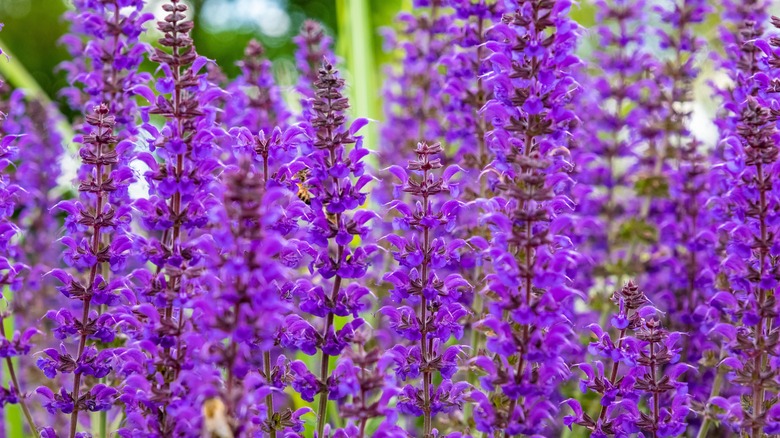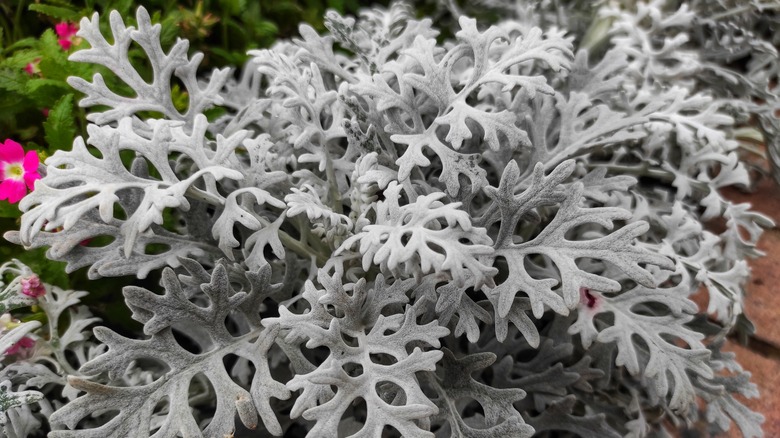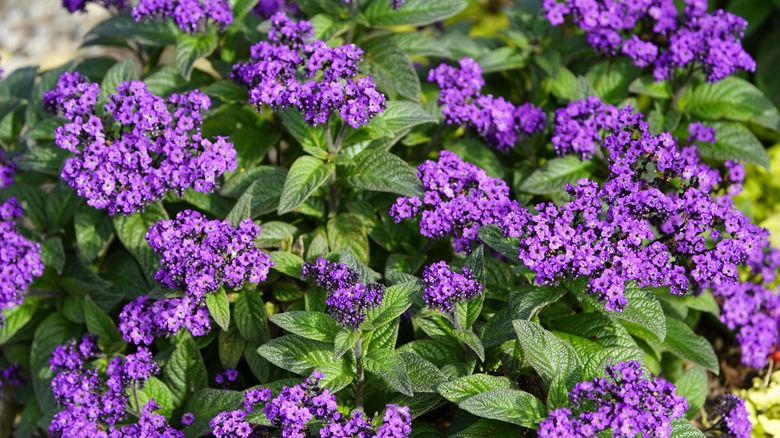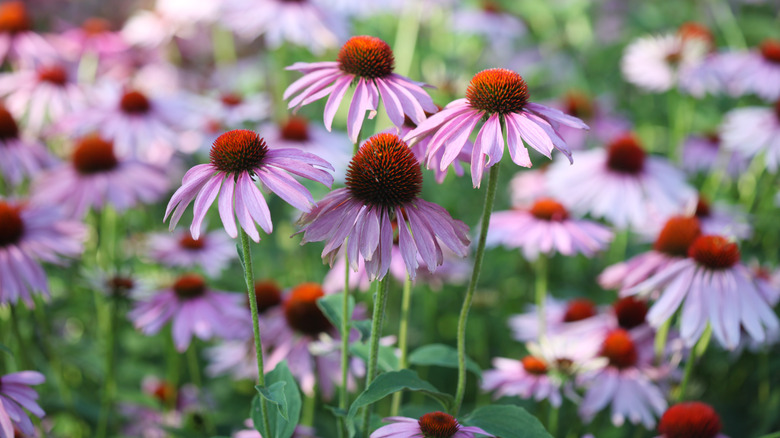Your Petunias Will Thrive Alongside These 10 Companion Plants
Petunias are a genus with around 35 different species, all of which are flowers that even the worst gardeners can handle. These fast-growing plants begin showing their bright trumpet-shaped blooms by the end of spring, creating the perfect nutrition source for several pollinators. Not only are they a stunning addition to the garden, but they're relatively easy to care for. Being somewhat drought-tolerant, they'll only require weekly watering, unless it's a dry, hot period. No matter what you're looking for, you'll always get what you need with this charming plant. Colors include white, pink, purple, yellow, orange, red, green, or even hybrids with different colored stripes. Plus, they're non-toxic, so if a curious child or pet decides they want to taste-test them, it won't harm them.
Thankfully, there are several flowering species that work well in a garden with petunias. Like many flowers, petunias thrive in a spot in your yard with full sun and well-draining soil. However, during the hottest summer days, their delicate petals tend to do better with a little protection, so partial shade during intense afternoon heat will promote more vibrant blooms. They like acidic soil with a pH ranging from 6.0 to 7.0, though they're not too picky, so long as the soil doesn't hold onto water. Ideally, you'll want to choose varieties with similar care requirements as petunias, so the whole garden can grow and thrive together.
Salvias
Also known as sage, salvias are an easy-to-grow herb that provides several benefits to your garden. Yes, it's the same type of sage you find in several culinary dishes. The leaves have a delicious savory flavor that not only complements your favorite foods, but releases an aroma that acts as a deterrent to several pests. It's not just the aromatic foliage that makes salvia a must-have addition; these plants also bloom gorgeous tubular flowers that attract hummingbirds to your garden. The colorful upright spikes of flowers contrast beautifully against the larger funnel-shaped petunias. You can find salvia varieties in pink, purple, red, and white, while petunias come in nearly every shade of the rainbow. So, your garden will never be boring with these two companion plants.
The care for both salvias and petunias is relatively straightforward. Like petunias, sage prefers to be planted in a location with well-draining soil and full sun. However, you may need to provide some shade from the harsh sun in USDA Plant Hardiness Zones 8 and above. Although salvias are somewhat drought-tolerant, they do best with regular watering. Once established, you can expect blooms from both plants from spring until frost, keeping your garden bursting with color for several months. As both of these are attractive to pollinators, you can enjoy visits from several beneficial species. While salvia isn't generally considered an invasive species, there are four varieties that can be problematic in certain regions: salvia aethiopis, salvia sclarea, salvia glutinosa, and salvia reflexa.
Lobelias
Lobelias are known for their clusters of blossoms that come in vibrant blues, purples, and reds. Uniquely eye-catching, their trailing growth habit pairs nicely against the petunias, which tend to clump. While they may seem like dainty flowers, they're a lot stronger than they look and don't require too much extra care to stay happy. Their tiny blooms emit a subtle, pleasant fragrance that isn't just loved by humans, but attracts several pollinators like bees and butterflies. Oddly enough, some believe that the scent also works as a natural pest deterrent against garden enemies like whiteflies and aphids. However, the effectiveness may vary, and there is only anecdotal evidence to support this plant's pest-repelling abilities.
Don't let their delicate appearance fool you; lobelias are relatively hardy. While petunias prefer to live in a sunny location, lobelias do well in part shade to full sun. However, their fine petals may need some shelter if your area tends to get hot afternoon sun. Like petunias, lobelias must be in well-draining soils and don't like their feet getting too soggy. You may need to give them an extra watering during extreme dry periods, though. Unlike most flowering plants, you won't need to deadhead lobelias because they naturally drop their spent flowers. It's important to note that all parts of lobelias are extremely toxic to humans and pets, so be mindful when planting if you have curious animals or kids.
Snapdragons
Snapdragons are a small genus of about 20 species, ranging in size, color, and even shape. With the different varieties to choose from, you can find the perfect spot for snapdragons, whether you want them in a garden bed, container, or flowing over a hanging planter. Their pretty blooms serve many pollinating species, though they heavily rely on bigger bumblebees, as they can more easily get into the opening where the nectar is. Once the snapdragons are in bloom, you can wow guests by cutting them and placing the stunning flowers in vases around your home. However, while some have a light, sweet fragrance, most don't have much of a scent.
Plant snapdragons in neutral and well-draining soil in a spot where they will receive full sun to partial shade. You'll need to water seedlings regularly and keep the soil moist for a few weeks for them to flourish. Once they reach adulthood, an inch of water each week without rain will keep them happy. To avoid damaging their delicate petals, aim the water near the crown, rather than watering overhead. The only downside to these garden favorites is their short flowering season, so it's best to plant them when temperatures are relatively cool. Once it heats up to 80 degrees Fahrenheit, their blooming will slow down.
Gauras
Also known as wandflowers or bee blossoms, gauras are herbaceous perennials that grow from 15 to 48 inches tall, depending on the variety. These low-maintenance beauties feature tiny 1-inch white or pink blooms against attractive pink, cream, or gold-tinged foliage. Their nectar brings in several long-tongue bee species, with butterflies occasionally paying a visit. Although you'll get the most blooms in the summer, this long-blooming species will also reward you with spring and fall flowers. Although gauras are self-seeding, they're a native plant that isn't considered an aggressive spreader, so they're pretty easy to control.
Even newbie gardeners can grow and take care of gauras. As long as it's well-draining, gauras aren't picky about soil types and will thrive in acidic to alkaline blends. They're relatively drought tolerant and only need deep waterings when the soil completely dries out. Like petunias, gauras thrive in full sun, though they can tolerate a bit of shade in the hot afternoons. If you have pets or kids frolicking in your garden, you can safely plant gauras, as they're non-toxic to humans, cats, and dogs.
Dusty millers
There aren't too many flowers that don't look stunning when paired against the frosty foliage that dusty millers have to offer. Also referred to as silver ragwort, this plant features large, deeply serrated leaves with numerous tiny white hairs, giving them a fuzzy, silvery appearance that looks straight out of a Christmas movie. They may not be adored for their flowers, though they do have yellow or cream blooms that may attract some pollinators. Because they grow through underground runners, they make beautiful ground covers, though they don't spread in a way that will dominate your other flowers.
Dusty millers are versatile enough that you can plant them nearly anywhere. They do well in containers, borders, and in mixed flower beds as an accent plant. No matter where you stick them in the soil, they don't need much to be happy, as long as their feet don't stay too wet. Dusty miller is a heat- and drought-tolerant plant once it's established and can even tolerate poor soils. The one thing this species doesn't like is shade; it will grow leggy if not placed in a sunny area. However, this preference is backed by petunias, so they can happily grow and bask in the sunlight together. The only downside is dusty miller is somewhat toxic and can cause intestinal upset if ingested by pets.
Heliotrope
Heliotrope is a rather large genus of over 300 flowering plants that belong to the Boraginaceae, or forget-me-not, family. Some people call them the cherry pie plant because of their delicious scent that evokes the familiar aroma of the American favorite dessert. This bushy plant with clusters of flowers adds a delicate and romantic touch, contrasting beautifully with the big, beautiful blooms petunias have to offer. Though purple is the most common flower color, there are varieties in shades of blue, pink, white, and yellow. Although the blooms are tiny, hummingbirds, butterflies, and other insect pollinators will flock to them.
While technically a perennial, heliotropes are grown as annuals in many climates. Heliotropes can be a little particular about their soil requirements. They prefer rich, loamy soil that drains well while staying a little moist, with a pH between 6.6 and 7.3. Unlike many of the other species, they need lots of water to thrive, though they can't handle being waterlogged. Six hours of direct sunlight is ideal, though they may need some shade when the sun is at its hottest. Be cautious of where you plant this species, as it's toxic to humans and animals when ingested.
Geraniums
Geraniums are a popular flower choice due to their low-maintenance qualities and unique fragrance that's sweet and fruity with a touch of spice. There's a variety for nearly every garden, whether you want to place them in pots, hanging planters, or directly in the ground. These five-petaled blooms grow in clusters and come in shades of white, pink, purple, red, and salmon. Some varieties even produce multi-colored blooms, adding even more dimension to your display. One of the best features geraniums have to offer is their long blooming period, which lasts from spring to fall. All you need to do is deadhead them when needed, and they'll push out more flowers for you to enjoy.
Planting geraniums next to petunias is a no-brainer because of their similar care requirements. They both prefer full sun with some slight shady protection from hot afternoon rays. Each plant also needs well-draining soil with a pH of around 6.0. Young plants will need watering two to three times per week, though established plants only need to be watered when the soil dries out. Geraniums are toxic to dogs, cats, and horses, so it's vital to make sure you only plant them in areas you know your beloved animals won't be tempted to take a bite.
Coneflower
If you want to start a pollinator garden, then look no further than the famous coneflower, as several species love them as much as we do. While you may immediately think of the purplish hue when imagining this species, there are several varieties in nearly every color. You can get them in shades of white, yellow, peach, orange, pink, red, and even green. Coneflowers are a deer-resistant plant that can save your garden, which is a huge plus, considering petunias are one of their favorite snacks. While no plant is truly a deer repellant, coneflowers are listed on Michigan State University's list of plants rarely damaged by deer. As a bonus, an animal we like seeing in the garden, birds, love snacking on coneflower seeds.
While coneflower and petunia plants prefer the same neutral to slightly acidic soil, they don't agree on fertilizer. However, all you need to do to keep them both happy is to give petunias the fertilizer they need and be vigilant about removing any weeds that may pop up. Aside from that, they're on the same page with nearly all their other conditions. Each plant thrives when receiving at least six hours of sunlight daily and needs well-draining soil. Coneflower is drought-tolerant, so if you go on a trip or forget to water your flowers for a week, these pretty blooms will still show up for you.
Asters
Asters are one of the plants that will fill your garden with a variety of butterflies, so be sure to add some if you love pollinators. These attractive daisy-like blooms are also sure to bring birds into your garden during the winter when they feed on their seeds. Not only do these flowers encourage biodiversity, but they're deer-resistant, which can help protect your petunias from being eaten. There are hundreds of varieties to choose from, ranging in height from 1 to 6 feet and in several shades like pink, purple, blue, and white. Asters grow quickly, giving you a stunning display during their blooming period that starts in the summer.
With over 600 varieties, each type of aster has its own set of growing preferences. However, for the most part, they're agreeable with the conditions that petunias thrive in. Both plants love neutral to slightly acidic soil that's well-draining. You can also keep them in a sunny spot where they can soak up the rays during summer. Asters like their soil to be evenly moist without being overly saturated. When watering, do your best to keep the leaves dry as possible, as they're prone to getting mildewy. While it's not great for pets to eat too much of any plant, asters are considered non-toxic to humans, dogs, cats, and livestock.
Candytuft
If you want colorful flowers that bloom in your garden in early spring, look no further than candytuft. This low-growing ground cover makes a stunning addition to nearly any garden, with its unique display of pink or white petals. Its beautiful blooms last until mid-summer, with some cultivars reemerging in mid-fall. The flower clusters emit an attractive fragrance that's like a magnet to pollinating species like butterflies and bees. Not only do they bring in beneficial insects, but they don't have any serious pest or disease issues. However, slugs, snails, and caterpillars may take a nibble or two if you don't keep an eye on them.
Candytuft's simple and unique appearance helps to make a gorgeous backdrop for petunias when they're living in the same garden. Thankfully, they make good companions and enjoy similar growing conditions. These flowers thrive in full sun, though they can tolerate light shade. That said, the more sunlight they receive, the more flowers they'll put out. They require slightly dry, well-draining soils and can tolerate nearly any soil type, though they prefer alkaline to neutral soil. Because petunias like acidic to neutral soil, it's best to choose a blend that falls within the neutral pH zone to keep them both happy.










